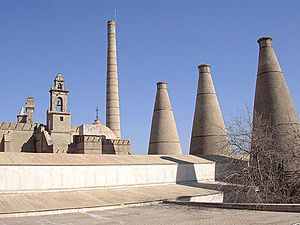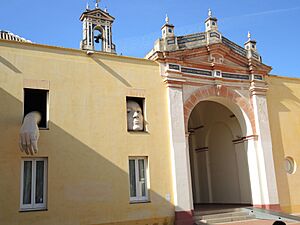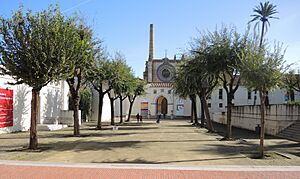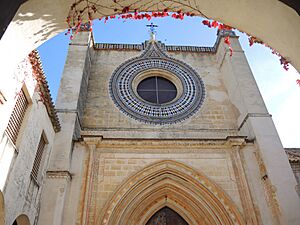Monastery of Santa Maria de las Cuevas facts for kids
Quick facts for kids Monasterio de Santa María de las CuevasMonastery of Our Lady of the Caves |
|
|---|---|

Monastery of the Cartuja
|
|
| Religion | |
| Affiliation | Secularized |
| Status | CAAC (Andalusian Center of Contemporary Arts) |
| Location | |
| Location | Seville, Andalusia, Spain |
| Architecture | |
| Architectural type | Monastery |
| Architectural style | Mudéjar-Gothic-Reinaissance-Baroque |
The Monastery of Santa María de las Cuevas is a very old and important building in Seville, a city in southern Spain. It's also known as the Monastery of the Cartuja. Today, this historic place is home to the Andalusian Contemporary Art Center (CAAC), a museum where you can see modern art.
Contents
A Look Back: The Monastery's Story
How the Monastery Began
Long ago, people believed this area had many caves. Potters used these caves for their ovens and to get clay. A legend says that after Christians took over Seville in the 1200s, they found a hidden image of the Virgin Mary inside one of these caves.
This discovery led to building a small chapel called Santa María de las Cuevas. Later, in the 1400s, the archbishop of Seville and a noble family helped start a Franciscan monastery here. Over time, more buildings were added. In the 1400s, monks from the Carthusian Order, who live a quiet life, moved into the monastery.
Christopher Columbus's Resting Place
Did you know that the famous explorer Christopher Columbus was once buried here? His remains were first in a city called Valladolid. Then, his son Diego had them moved to the Monastery of the Cartuja. Later, in 1542, his remains were moved again to Santo Domingo.
Changes Over Time
During the time of the Napoleonic invasion, the monastery was taken over. It was used as a place for soldiers to stay. After the soldiers left in 1812, the monks returned for a short time. However, in 1835–1836, many monasteries in Spain were closed down. This monastery was one of them, and the monks had to leave for good.
From Monastery to Pottery Factory
Charles Pickman's Vision
After the monastery closed, an Englishman named Charles Pickman bought the building in 1839. He started a ceramics factory there in 1841. Pickman brought in new ideas and ways of making pottery. He imported materials, used special machines, and hired skilled potters from Britain and nearby Triana.
A Famous Pottery Brand
The factory, called La Cartuja de Sevilla, quickly became very successful. Its pottery was popular all over Europe and in countries in Latin American. The factory won many awards at big international exhibitions. In 1871, the King of Spain even named it a supplier to the Royal House. Charles Pickman was also given the title of Marquis.
The factory kept making pottery until 1984. Today, you can still see the tall chimney and the special bottle-shaped kilns. These are reminders of the busy pottery factory that once operated here.
A Modern Art Museum
Becoming a National Monument
In 1964, the monastery was declared a national monument. This means it was recognized as a very important historical site. The government of Andalusia now owns the building. For the Seville Expo '92, the monastery was restored and made beautiful again.
The Andalusian Contemporary Art Center
In 1997, the older parts of the monastery became home to a modern art museum. This is the Centro Andaluz de Arte Contemporáneo (CAAC). The CAAC was created in 1990 to study, protect, and share contemporary art.
The CAAC has many activities. They hold temporary art shows, workshops, concerts, and talks. Their goal is to help people learn about modern art from all over the world. The museum's permanent collection includes works by famous artists like Luis Gordillo and Louise Bourgeois. It also focuses on art from Andalusia and how it connects to art from other places.
When you visit the CAAC, you can also explore the historic parts of the old monastery. You can see the old chain door, different chapels, the church, cloisters, and beautiful gardens. It's a place where history and modern art come together!
See also
 In Spanish: Monasterio de la Cartuja (Sevilla) para niños
In Spanish: Monasterio de la Cartuja (Sevilla) para niños





